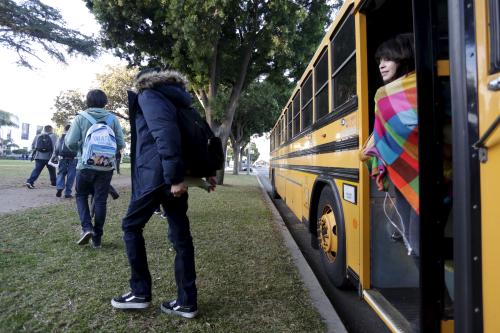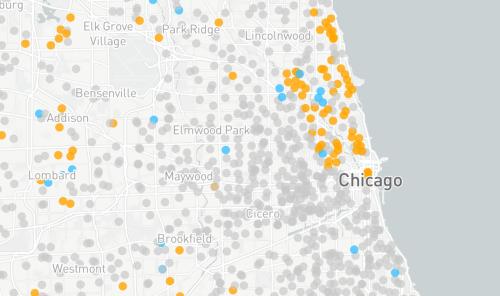To a very large extent, school segregation is a mechanical result of residential segregation. America’s public schools, by and large, look like America’s neighborhoods. That’s the broad conclusion of our new report “Balancing Act: Schools, Neighborhoods, and Racial Imbalance.” Explore the accompanying interactive to see the racial mix of every school and neighborhood in the U.S.
We construct measures of racial balance by comparing the racial composition of each school to the racial mix of the under-18 population in census blocks falling within a two-mile radius of the school. The average public school is 2.6 percent less white, 1.8 percent more black, 0.9 percent more Hispanic, and 0.3 percent more Asian than its surrounding neighborhood. (We repeat the exercise at different distances, and using alternative methods, with similar results).
In our main analysis, we look at neighborhoods around schools within school districts. If a census block is within the two-mile radius but in another school district, it does not count as part of the neighborhood that we are comparing to the school. The intuition here is to compare neighborhoods to the schools that children from those neighborhoods are likely or able to attend.
But what if school districts themselves are segregated along racial lines? Then schools near the district boundary might look racially balanced by comparison to the neighborhood within the district, but not if we include census blocks from across the boundary.
We test this by repeating our analysis but without restricting our neighborhoods to school districts. In most places, the results are similar. In the state of Illinois, the most racially representative state in the nation, the average white, black and Hispanic imbalance scores using our main method are -3.6 percent, +2 percent, and +0.8 percent, respectively. When we take all blocks within two miles, these are -3.5 percent, +2 percent, and +0.7 percent, respectively. Barely a shift.
But there are places where the district boundaries matter a lot. Long Island NY, for example, has 125 small, fragmented school districts:
When we compare Long Island schools to neighborhoods within districts, they look racially balance. The schools in Floral Park-Bellrose Union Free School District, NY, for example, have an overall racial imbalance score of around -1 percent for whites and just under 1 percent for blacks. But if we ignore the district boundaries and define our neighborhoods purely on the basis of the two-mile radius, the results are dramatically different: a racial imbalance score of +42 percent for whites and -23 percent for blacks.
Comparing all the districts on Long Island, NY we find that schools in the following school districts show the most variation in the racial balance scores generated with and without the within-district condition:
Given some of these results, it is no surprise that Long Island is witnessing some fierce debates over efforts to consolidate schools and make them more geographically expansive. Long Island provides a good example of the potential for school district boundaries to impact the racial balance of schools, given the relatively small size of the districts. But there are similar patterns elsewhere: in our paper we conduct a similar analysis of the Camden, New Jersey area. A recent report from the Center for American Progress shows that many states have such small, nonremote districts. (This may also mean higher costs of administration because of lost economies of scale: the CAP authors estimate that in New Jersey alone this could be as high as $100 million).
In places like Long Island, the district boundaries have been in place for a long time; what has changed is the racial diversity of the communities within them. But in other parts of the country school district boundaries have been altered, sometimes with the effect of creating more racial segregation between districts, and therefore schools. Scholar Genevieve Siegel-Hawley labels this a form of “educational gerrymandering”. The most troubling trend is of school district “secessions”, with predominantly affluent, white suburban communities forming their own, new school district.
The bottom line here is that while school integration has to be seen in the context of neighborhood integration, educational policy matters too – not least in the size, shape and composition of our school districts.









Commentary
How school district boundaries can create more segregated schools
November 20, 2017